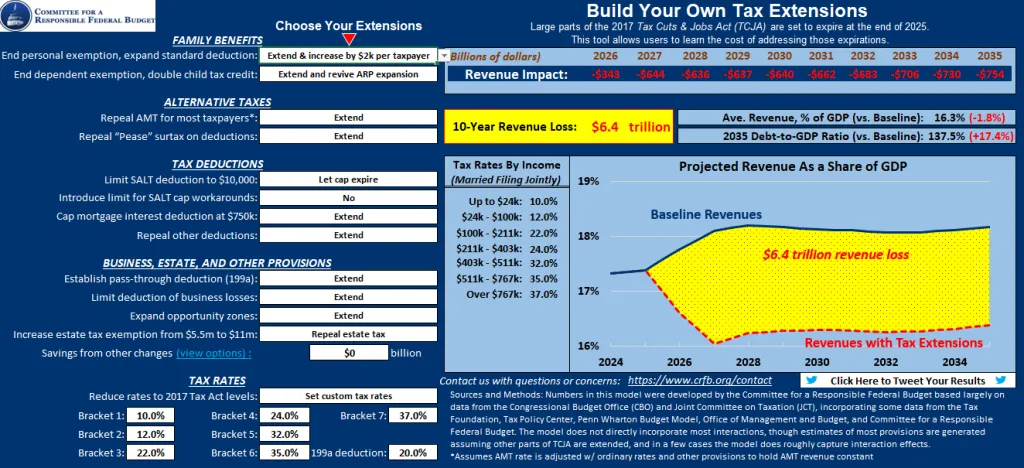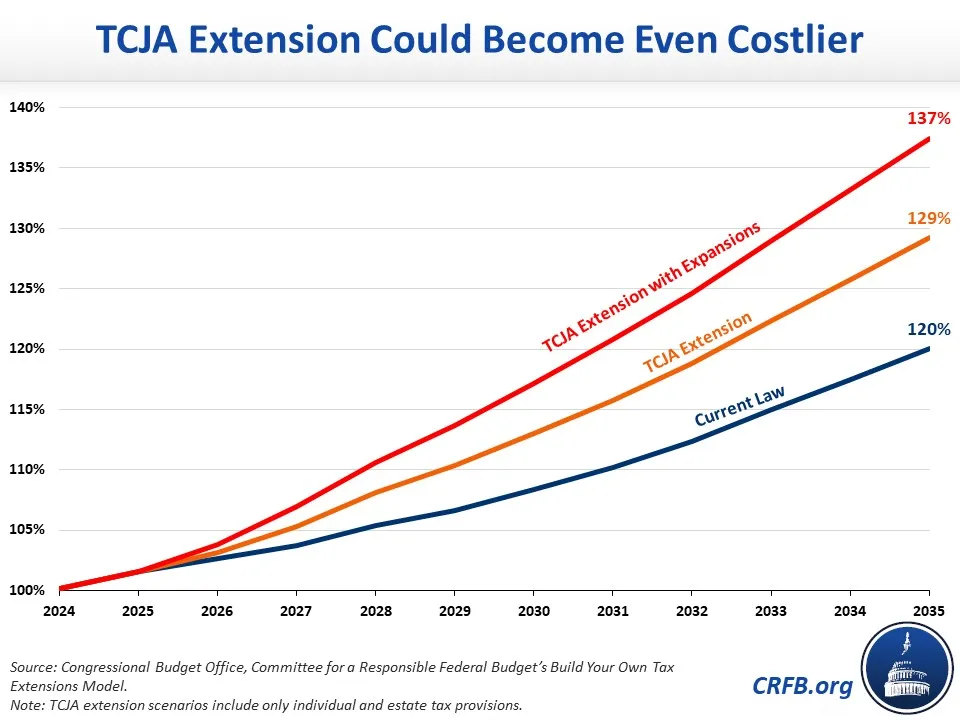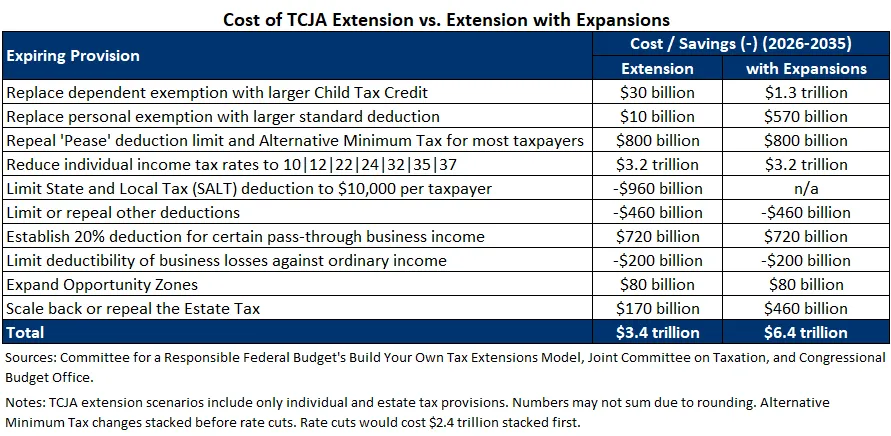TCJA Expansions Could Balloon Cost of Extensions
Extending various income and estate tax provisions of the Tax Cuts and Jobs Act (TCJA) expiring after 2025 would cost $3.4 trillion through 2035. Rather than beginning to discuss how to limit and offset these costs, however, many politicians in both parties are focused on expanding parts of the TCJA. We estimate an expanded TCJA could cost up to $6.4 trillion to extend through 2035.
The TCJA roughly doubled the Child Tax Credit, the standard deduction, and the estate tax exemption, while imposing a $10,000 per tax unit cap on the state and local tax (SALT) deduction and eliminating the personal and dependent exemptions. Some policymakers have proposed further expansions of the Child Tax Credit increase and the standard deduction, further cuts to the estate tax, and an increase or repeal of the SALT cap.
Under one scenario, extending the TCJA with these expansions and without offsets would:
- Reduce revenues by $6.4 trillion through 2035.
- Increase debt to 137 percent of GDP by 2035 (compared to 120 percent under current law).
- Boost deficits to over 9.0 percent of GDP by 2035 (compared to 6.7 percent under current law).
For reference, a straight extension of the TCJA individual and estate tax provisions expiring in 2025 without offsets would lose $3.4 trillion of revenue, boost debt to 129 percent of GDP, and increase deficits to 7.9 percent of GDP by 2035.
CRFB’s Build Your Own Tax Extensions tool, currently in beta (download here) (find our updated web-based version here), allows users to design their own TCJA extension and see a rough estimate of the year-by-year costs through 2035. The tool focuses on individual and estate tax provisions that generally expire at the end of 2025, assuming business provisions that change earlier are dealt with separately, if at all.
While a straight extension would cost $3.4 trillion, combining extensions with expansions could cost far more. As an illustrative example, we estimated the cost of extending the TCJA along with the following expansions:
- Increasing the Child Tax Credit from $1,000 to $3,000 (instead of $2,000), with full refundability and a $600 bonus for children under the age of six as was law for 2021 under the American Rescue Plan and was proposed in the House’s Build Back Better bill, the President’s budget, and elsewhere.
- Increasing the standard deduction from roughly $8,000 per adult to about $17,000 (instead of $15,000) per adult, as proposed in the Tax Cuts for Working Families Act.
- Eliminating the estate tax (instead of extending the exemption increase from $5.5 to $11 million per adult), as proposed in the Death Tax Repeal Act of 2023 and the Permanently Repeal the Estate Tax Act of 2023.
- Allowing the $10,000 SALT cap to expire, as suggested by numerous politicians in both parties, with significant increases or a repeal of the cap proposed in the House’s Build Back Better bill, the SALT Fairness Act of 2023, and the Tax Relief for Middle Class Families Act of 2023.
Assuming all these expansions were in effect by the beginning of 2026, the revenue loss from extending and expanding the TCJA would be about $6.4 trillion through 2035, including over $750 billion in 2035 alone. This is $3.0 trillion larger through 2035 than a simple extension of the TCJA and $350 billion larger in 2035.

Build Your Own Tax Extensions here
Without offsets and including interest, this extension would add $7.4 trillion to the debt by 2035, the equivalent of 17.4 percent of GDP. Under these extensions, debt would rise from 102 percent of GDP in 2025 to 137 percent by the end of 2035. By comparison, debt is projected to reach 120 percent of GDP under current law and 129 percent under a straight extension of the TCJA’s individual and estate tax provisions without offsets.
Assuming this expanded extension of the TCJA is enacted without offsets, deficits as a percentage of GDP would rise from 6.5 percent in 2026 to 9.0 percent by 2035 and primary deficits (excluding interest) would grow from 3.7 percent to 4.7 percent. These deficits would be far larger than current law projections, under which total deficits as a percentage of GDP rise from 5.3 percent in 2026 to 6.7 percent by 2035 and primary deficits grow from 2.5 percent to 2.9 percent.

To be sure, even extending the existing parts of the TCJA without offsets would be an incredibly costly mistake. With debt approaching record levels and projected to grow rapidly, any responsible TCJA extension must be carefully designed and fully paid for.
But expanding the TCJA would turn this budget buster into a fiscal fiasco. This extreme case could nearly double the cost of extension. Policymakers should thus avoid any significant expansions of the TCJA absent a plan to fully finance the expansion and extension. Instead, they should carefully consider which, if any, parts of TCJA are worth extending and ensure any extensions are at least fully paid for in a way that allows the country to raise adequate revenue to meet its needs.



